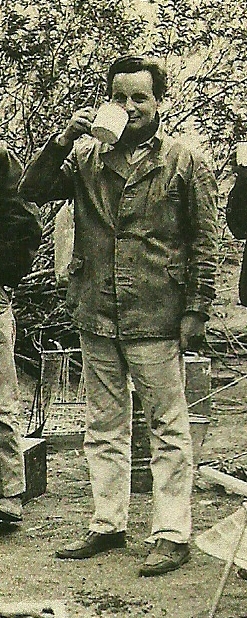José Bonaparte facts for kids
Quick facts for kids
José Bonaparte
|
|
|---|---|

Bonaparte in 1964
|
|
| Born | 14 June 1928 Rosario, Santa Fe, Argentina
|
| Died | 18 February 2020 (aged 91) Mercedes, Buenos Aires, Argentina
|
| Nationality | Argentine |
| Scientific career | |
| Fields | Paleontology |
José Fernando Bonaparte (born June 14, 1928 – died February 18, 2020) was a famous Argentine paleontologist. He found many dinosaur fossils in South America. He also helped teach and guide a new group of Argentine paleontologists. Many people consider him one of the most important paleontologists from Argentina. Peter Dodson, another paleontologist, said Bonaparte was "almost singlehandedly" responsible for Argentina becoming a top country for dinosaur discoveries.
Contents
About José Bonaparte
José Bonaparte was born in Rosario, Santa Fe, Argentina. His father was an Italian sailor. José grew up in Mercedes, Buenos Aires. Even though he didn't have formal training in paleontology, he loved collecting fossils. He started collecting them with his friends when he was young. They even created a small museum in their hometown!
Later, he became a curator at the National University of Tucumán. A curator is someone who manages a museum's collections. In 1976, the university gave him an honorary degree. This means they recognized his great work even without a traditional degree. In the late 1970s, he became a senior scientist at the Museo Argentino de Ciencias Naturales in Buenos Aires.
Bonaparte was very dedicated to his work. He received special funding from the National Geographic Society many times. He was known for being hard-working and determined. He passed away peacefully in his sleep on February 18, 2020, at the age of 91.
His Discoveries and Career
Finding Dinosaurs in the South
Between 1975 and 1977, Bonaparte worked on digging up the Saltasaurus dinosaur. He worked with Martín Vince and Juan C. Leal at a place called "El Brete." They reported this amazing find in 1977.
With his fellow Argentine scientist Jaime Powell, Bonaparte studied the Saltasaurus. They found that this dinosaur had special armored plates, called osteoderms, in its skin. Imagine a dinosaur wearing its own armor!
Bonaparte also found many other dinosaurs in South America. These included twenty examples of Kritosaurus australis and a type of Hadrosaur dinosaur. Based on these finds, he thought that many different animal species had moved between North and South America a long time ago. This happened at the end of the Mesozoic Era, which is often called the "Age of Dinosaurs."
The Ancient Continents
Millions of years ago, all the continents were joined together in one giant supercontinent called Pangaea. During the Jurassic period, Pangaea started to split apart. It formed two big landmasses: Laurasia in the north and Gondwana in the south.
Later, during the Cretaceous period, South America separated from the rest of Gondwana. This separation caused the animals in the north and south to develop very differently. The animals found in the southern parts of the world often look quite unique compared to those from the north. Bonaparte's discoveries really showed how different these southern animals were. Because of his incredible work, paleontologist Robert T. Bakker called him the "Master of the Mesozoic."
Amazing Dinosaur Finds
José Bonaparte discovered many incredible dinosaurs from the Southern Hemisphere. Here are some of them:
- Abelisaurus (1985)
- Agustinia (1998)
- Alvarezsaurus (1991)
- Amargasaurus (1991)
- Andesaurus delgadoi (1991)
- Argentinosaurus (1993)
- Argyrosaurus superbus (1984)
- Carnotaurus (1985)
- Coloradisaurus brevis (1978)
- Guaibasaurus candelariensis (1998)
- Kritosaurus australis (1984)
- Lapparentosaurus madagascariensis (1986)
- Ligabueino andesi (1996)
- Mussaurus (1979)
- Noasaurus (1980)
- Piatnitzkysaurus (1979)
- Rayososaurus agrioensis (1996)
- Riojasaurus (1969)
- Saltasaurus (1980)
- Velocisaurus (1991)
- Volkheimeria chubutensis (1979)
- Ligabuesaurus leanzai (2006)
He also helped find the famous Giganotosaurus.
How He Studied Fossils
For a long time, Bonaparte used traditional ways to study fossils. He didn't use newer methods like cladistic analysis. This is a way scientists figure out how different animals are related to each other. It's like building a family tree for species.
However, later in his career, around the year 2000, Bonaparte started using these newer methods. For example, his studies of long-necked dinosaurs called sauropods (like Ligabuesaurus) and early mammals from Brazil used these modern techniques.
Even though he is most famous for his dinosaur discoveries, José Bonaparte actually preferred to study the fossils of mammals. He taught and inspired many students who became important paleontologists themselves. Some of his notable students include Rodolfo Coria, Luis Chiappe, Fernando Novas, Jaime Powell, Guillermo W. Rougier, Leonardo Salgado, Jorge Calvo, Sebastián Apesteguía, and Agustín Martinelli.
See also
 In Spanish: José Fernando Bonaparte para niños
In Spanish: José Fernando Bonaparte para niños

